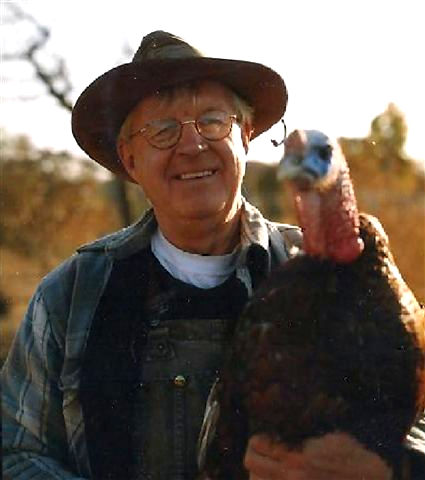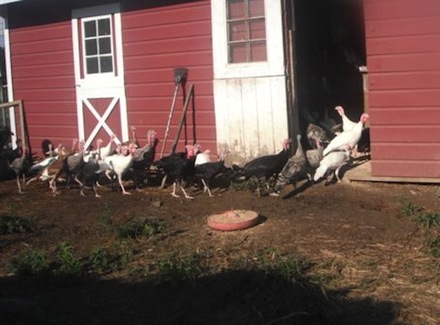AgriCulture bloggers Peter Davies and Mark Scherzer are the owners of Turkana Farms in Germantown, NY. This week Peter writes. I guess all of us are creatures of habit, some more than others. Mark is almost totally so. He would be content in the same place, doing the same exact thing, day after day into infinity, happy as a clam. I, on the other hand, am always looking for a change and am especially looking forward to a complete change in late September when we set off on what will be for me four weeks in Turkey, for Mark three. I usually do my best to move through the day with as little structure as possible despite the rigid daily routines of the farm.

Animals, too, I have discovered, are largely creatures of habit, some more markedly than others. How-to-farm-books, for instance, warn that it is best to try to wear the same outfit as much as possible on a daily basis when doing farm chores, as the animals expect it. I saw one example of this a few years ago when I appeared at the piggery during a heavy rain in a canary yellow rubberized raincoat. I casually reached in, as I typically do, to pet our loveable boar Vernon, who usually relishes the attention, but was shocked to have him, for the first time, snap at me. Apparently he was habitually used to seeing me in my everyday drab Carhart work jacket. And I have noticed that if I appear without a hat it tends to surprise my critters, whether they be sheep, cows, pigs, or poultry. I can change from a straw to a suede Tilbury hat and it doesn’t seem to bother them, but no hat often does. Sometimes I run down to the basement where our cats sleep, in my underwear, to feed them. As I fill their feed bowls, I am sure I have detected a look of consternation from them at the sight of my bare legs. “How does he do it – these constant changes in his skin and fur?" I am sure they are thinking. Perhaps the farm critters that are the most creatures of habit are our flock of Toulouse geese. At the end of the day they are usually gathered near the entry to their overnight pen, and several of them raise the alarm as I come through the pasture gate. They obviously know I am due and are gathered to await my commands. Just a few movements of my arms and a gradual, stealthy approach sends them with almost military precision through the gate into their antechamber and on through the hatch into the night pen. I have the sense that I have satisfied their expectations. They even seem to show signs of knowing my habits. They know that in the morning, once I have filled their grain pan and waterers, I will move to the big gate that leads to the compounds I need to pass through to get to the turkeys. In anticipation they troop over to the gate and await my arrival, happily gabbling away.

Maybe no group is more set in its way than our flock of Karakul sheep. Particularly when it comes to their grain treat, which they get in the morning and the end of day. They are either all congregated outside or near the barn at grain treat time or, if they are out on pasture, they seem to have sentinels stationed to announce my appearance. I see heads pop up out in the pasture, and the stampede to the barn begins. While they do not wear wrist watches, they do have a vague sense of time. And if their grain treat is not laid out for them in a timely fashion (Mark tends to run on a later schedule) they become impatient and begin baaing with what sounds to me like a strong sense of entitlement. If I stand in the barn during grain treat time I frequently look down to find – munching away right next to me – Orhan, Nilufer, and Sultana, our three bottle-fed lambs, now fully adult sheep. The three of them, in all kinds of ways, habitually seek me out, apparently still remembering the bond we established during those many weeks of five-a-day bottle feedings. Our heritage turkeys provide a good example of how livestock habits can be formed and shaped. About seven years ago, when nighttime predator attacks put a stop to our leaving our turkeys out at night to sleep in the apple trees, we had to devise a way of rounding up and driving in more than one hundred rather flighty critters every late afternoon.

By playing on their natural instinct to group together and move as a unit, that is, as a flock, I devised a routine, using several long wands, which ultimately became for them an expected habit. Moving slowly with arms and wands outstretched I herd them into a single flock, and then moving slowly and adjusting the wands I move the flock in the direction of the door to their nighttime sleeping porch. As they near the door I adjust the wands to encourage the turkeys nearest the door to enter the sleeping porch, and then direct the rest of the flock to follow. In a river-like flow, the flock passes in an orderly fashion into the sleeping porch. At first this routine has to be carefully controlled and choreographed but it is not long before the flock learns the drill, and begins to anticipate the daily event and will often (but not always) gather near the entrance to the sleeping porch, particularly if one of us is late in arriving. More and more as the days go by, the turkeys are habituated to the routine and it sometimes takes on the precision and polish of a circus act. This is not to say that things always run this smoothly, for these are wily, lively critters, and they have their moments of revolt, but on the whole they learn to habitually collaborate with us. Our British White beef cattle have set habits, too, but not so much in reference to us or what we do. They are an independent lot on the whole, and it is the weather that sets some of their major habits, particularly hot weather. After a morning of grazing they habitually escape the summer heat at midday by assembling near the fence just below our shade garden, the coolest and breeziest place in the farm, or beneath the deep shade of a row of catalpa trees that grow just along the pasture fence. There they lounge about a contented family pod, chewing their cud, busily flicking their ears and tails. Until, seeming to obey some unseen signal, they all slowly lumber to their feet one by one, and troop off to the water tank, or process out onto pasture. As winter sets in and the weather becomes increasingly unpleasant, a new herd habit is formed as they give up sleeping in the fields, and troop in from pasture to shelter in their cow shed for the night.

Probably the farm critters that are the least creatures of habit are our Rhode Island Red chickens, who, it seems to me, live a kind of anarchic existence, chiefly (when they are not sitting in their egg boxes) scurrying helter-skelter about their coop and yard, the supreme opportunists, in search of anything edible. They never assemble as a flock (unless maybe when in great danger) and seem to exhibit very little in the way of coordinated, predictable behavior. Unlike the convivial turkeys and militaristic geese, they seem incapable of learning habits and thus will not be herded or in any way controlled. Only dusk seems to have power over them, giving them one habit they all share, as they troop through the tiny hatch into the chicken coop, and quietly flutter up to their perches for the night. — Peter Davies









